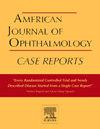Inappropriate administration of mitomycin in a cataract patient
Q3 Medicine
引用次数: 0
Abstract
Purpose
This case report describes the improper administration of intracameral mitomycin after cataract extraction in an 83-year-old male, demonstrating the need for system improvements to prevent “never events.”
Observations
An 83-year-old male presented with visually significant bilateral cataracts, (right eye (OD): 20/80, left eye (OS): 20/70). He underwent technically uncomplicated cataract surgery in the right eye. At postoperative visit one, vision was 20/250 OD, less than anticipated for unclear reasons. On subsequent visits, the patient was found to have worsening photophobia, increasing conjunctival inflammation, corneal edema, and an elevated intraocular pressure of 27 mmHg. Given the variety and complexity of symptoms despite an otherwise uncomplicated surgery, an investigation was launched. An investigation for Toxic Anterior Segment Syndrome (TASS) revealed a mix-up between Cefuroxime and Mitomycin during medication preparation and administration. It was determined that mitomycin was inadvertently injected intracamerally into the patient's eye, causing intraocular toxicity and ultimately, loss of vision.
Conclusions and importance
This case underscores the significance of system failures in the healthcare environment and how “never events” may occur even with appropriate protocols in place. The improper administration of mitomycin emphasizes the need for enhanced safety measures, including improved medication labeling, consistent use of time-outs, and reinforcing their importance in high-volume environments. System changes are essential to reduce the risk of errors and protect patient safety. The use of off-label, compounded medications should be minimized when possible. Ophthalmologists and the pharmaceutical industry should continue to seek an FDA-approved antibiotic for intraocular use in cataract surgery.
白内障患者丝裂霉素使用不当
目的:本病例报告描述了一位83岁男性白内障摘出术后不适当的乳内丝裂霉素的使用,表明需要改进系统以防止“从未发生的事件”。男性,83岁,双侧白内障,右眼(OD): 20/80,左眼(OS): 20/70。他接受了技术上并不复杂的右眼白内障手术。术后第一次就诊时,视力为20/250 OD,低于预期,原因不明。在随后的随访中,患者发现畏光加重,结膜炎症加重,角膜水肿,眼压升高27 mmHg。尽管手术并不复杂,但由于症状的多样性和复杂性,因此展开了调查。一项针对毒性前段综合征(TASS)的调查显示,在药物制备和给药过程中,头孢呋辛和丝裂霉素之间存在混淆。经确定,丝裂霉素被无意中注射入患者眼内,引起眼内毒性,最终导致视力丧失。结论和重要性本案例强调了医疗保健环境中系统故障的重要性,以及即使有适当的协议,“never event”也可能发生。丝裂霉素给药不当强调了加强安全措施的必要性,包括改进药物标签,持续使用暂停,并加强其在大容量环境中的重要性。系统变革对于减少差错风险和保护患者安全至关重要。在可能的情况下,应尽量减少使用说明书外的复合药物。眼科医生和制药行业应该继续寻求fda批准的用于白内障手术的眼内抗生素。
本文章由计算机程序翻译,如有差异,请以英文原文为准。
求助全文
约1分钟内获得全文
求助全文
来源期刊

American Journal of Ophthalmology Case Reports
Medicine-Ophthalmology
CiteScore
2.40
自引率
0.00%
发文量
513
审稿时长
16 weeks
期刊介绍:
The American Journal of Ophthalmology Case Reports is a peer-reviewed, scientific publication that welcomes the submission of original, previously unpublished case report manuscripts directed to ophthalmologists and visual science specialists. The cases shall be challenging and stimulating but shall also be presented in an educational format to engage the readers as if they are working alongside with the caring clinician scientists to manage the patients. Submissions shall be clear, concise, and well-documented reports. Brief reports and case series submissions on specific themes are also very welcome.
 求助内容:
求助内容: 应助结果提醒方式:
应助结果提醒方式:


